flat tire KIA Sedona 2012 2.G Owner's Manual
[x] Cancel search | Manufacturer: KIA, Model Year: 2012, Model line: Sedona, Model: KIA Sedona 2012 2.GPages: 370, PDF Size: 6.75 MB
Page 5 of 370
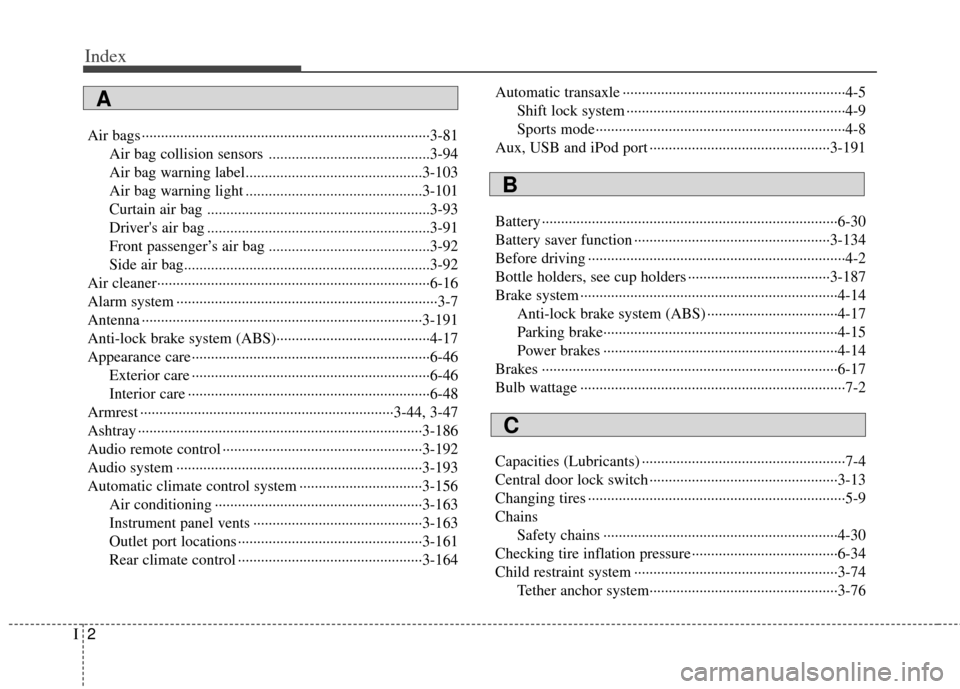
Index
2I
Air bags ··················\
··················\
··················\
··················\
···3-81Air bag collision sensors ..........................................3-94
Air bag warning label..............................................3-103
Air bag warning light ..............................................3-101
Curtain air bag ..........................................................3-93
Driver's air bag ..........................................................3-91
Front passenger’s air bag ..........................................3-92
Side air bag................................................................3-92
Air cleaner··················\
··················\
··················\
·················6-16\
Alarm system ··················\
··················\
··················\
··············3-7
Antenna ··················\
··················\
··················\
··················\
·3-191
Anti-lock brake system (ABS)··················\
··················\
····4-17
Appearance care··················\
··················\
··················\
········6-46 Exterior care ··················\
··················\
··················\
········6-46
Interior care ··················\
··················\
··················\
·········6-48
Armrest ··················\
··················\
··················\
············3-44, 3-47
Ashtray ··················\
··················\
··················\
··················\
··3-186
Audio remote control ··················\
··················\
················3-192
Audio system ··················\
··················\
··················\
··········3-193
Automatic climate control system ··················\
··············3-156 Air conditioning ··················\
··················\
··················\
3-163
Instrument panel vents ··················\
··················\
········3-163
Outlet port locations ··················\
··················\
············3-161
Rear climate control ··················\
··················\
············3-164 Automatic transaxle ··················\
··················\
··················\
····4-5
Shift lock system ··················\
··················\
··················\
···4-9
Sports mode··················\
··················\
··················\
···········4-8
Aux, USB and iPod port ··················\
··················\
···········3-191
Battery ··················\
··················\
··················\
··················\
·····6-30
Battery saver function ··················\
··················\
···············3-134
Before driving ··················\
··················\
··················\
·············4-2
Bottle holders, see cup holders ··················\
··················\
·3-187
Brake system ··················\
··················\
··················\
·············4-14 Anti-lock brake system (ABS) ··················\
················4-17
Parking brake··················\
··················\
··················\
·······4-15
Power brakes ··················\
··················\
··················\
·······4-14
Brakes ··················\
··················\
··················\
··················\
·····6-17
Bulb wattage ··················\
··················\
··················\
···············7-2
Capacities (Lubricants) ··················\
··················\
·················7-4
Central door lock switch ··················\
··················\
·············3-13
Changing tires ··················\
··················\
··················\
·············5-9
Chains Safety chains ··················\
··················\
··················\
·······4-30
Checking tire inflation pressure ··················\
··················\
··6-34
Child restraint system ··················\
··················\
·················3-74\
Tether anchor system··················\
··················\
·············3-76
A
B
C
Page 7 of 370
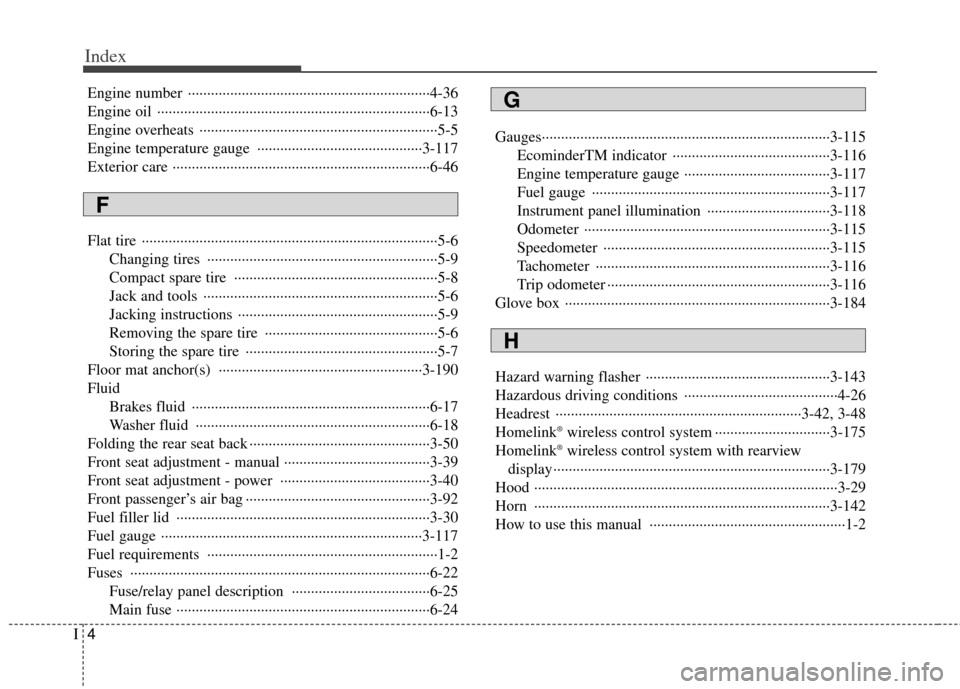
Index
4I
Engine number ··················\
··················\
··················\
·········4-36
Engine oil ··················\
··················\
··················\
·················6-13\
Engine overheats ··················\
··················\
··················\
········5-5
Engine temperature gauge ··················\
··················\
·······3-117
Exterior care ··················\
··················\
··················\
·············6-46
Flat tire ··················\
··················\
··················\
··················\
·····5-6Changing tires ··················\
··················\
··················\
······5-9
Compact spare tire ··················\
··················\
·················5-8
Jack and tools ··················\
··················\
··················\
·······5-6
Jacking instructions ··················\
··················\
················5-9
Removing the spare tire ··················\
··················\
·········5-6
Storing the spare tire ··················\
··················\
··············5-7
Floor mat anchor(s) ··················\
··················\
·················3-19\
0
Fluid Brakes fluid ··················\
··················\
··················\
········6-17
Washer fluid ··················\
··················\
··················\
·······6-18
Folding the rear seat back ··················\
··················\
···········3-50
Front seat adjustment - manual ···········\
··················\
·········3-39
Front seat adjustment - power ··················\
··················\
···3-40
Front passenger’s air bag ··················\
··················\
············3-92
Fuel filler lid ··················\
··················\
··················\
············3-30
Fuel gauge ··················\
··················\
··················\
··············3-117
Fuel requirements ··················\
··················\
··················\
······1-2
Fuses ·················\
··················\
··················\
··················\
·······6-22 Fuse/relay panel description ··················\
··················\
6-25
Main fuse ··················\
··················\
··················\
············6-24 Gauges··················\
··················\
··················\
··················\
···3-115
EcominderTM indicator ··················\
··················\
·····3-116
Engine temperature gauge ··················\
··················\
··3-117
Fuel gauge ··················\
··················\
··················\
········3-117
Instrument panel illumination ··················\
··············3-118
Odometer ················\
··················\
··················\
············3-115
Speedometer ···············\
··················\
··················\
········3-115
Tachometer ················\
··················\
··················\
·········3-116
Trip odometer ··················\
··················\
··················\
····3-116
Glove box ··················\
··················\
··················\
···············3-184
Hazard warning flasher ··················\
··················\
············3-143
Hazardous driving conditions ··················\
··················\
····4-26
Headrest ················\
··················\
··················\
············3-42, 3-48
Homelink
®wireless control system ··················\
············3-175
Homelink®wireless control system with rearview
display··················\
··················\
··················\
··················\
3-179
Hood ·················\
··················\
··················\
··················\
········3-29
Horn ·················\
··················\
··················\
··················\
······3-142
How to use this manual ··················\
··················\
···············1-2
F
G
H
Page 10 of 370
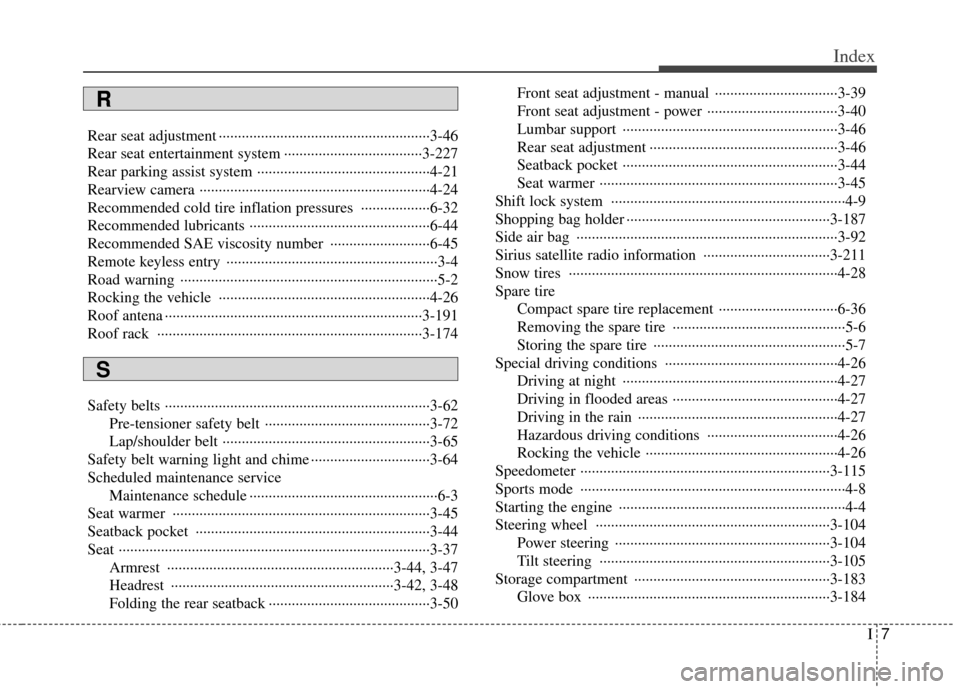
I7
Index
Rear seat adjustment ··················\
··················\
··················\
·3-46
Rear seat entertainment system ··················\
··················\
3-227
Rear parking assist system ··················\
··················\
·········4-21
Rearview camera ··················\
··················\
··················\
······4-24
Recommended cold tire inflation pressures ··················\
6-32
Recommended lubricants ··················\
··················\
···········6-44
Recommended SAE viscosity number ··················\
········6-45
Remote keyless entry ··················\
··················\
··················\
·3-4
Road warning ··················\
··················\
··················\
·············5-2
Rocking the vehicle ··················\
··················\
··················\
·4-26
Roof antena ··················\
··················\
··················\
·············3-191
Roof rack ··················\
··················\
··················\
···············3-174
Safety belts ··················\
··················\
··················\
···············3-62Pre-tensioner safety belt ··················\
··················\
·······3-72
Lap/shoulder belt ··················\
··················\
··················\
3-65
Safety belt warning light and chime ··················\
·············3-64
Scheduled maintenance service Maintenance schedule ··················\
··················\
·············6-3
Seat warmer ··················\
··················\
··················\
·············3-45
Seatback pocket ··················\
··················\
··················\
·······3-44
Seat ·················\
··················\
··················\
··················\
··········3-37 Armrest ················\
··················\
··················\
·······3-44, 3-47
Headrest ················\
··················\
··················\
······3-42, 3-48
Folding the rear seatback ··················\
··················\
······3-50 Front seat adjustment - manual ··················\
··············3-39
Front seat adjustment - power ··················\
················3-40
Lumbar support ··················\
··················\
··················\
··3-46
Rear seat adjustment ··················\
··················\
·············3-46
Seatback pocket ··················\
··················\
··················\
··3-44
Seat warmer ··················\
··················\
··················\
········3-45
Shift lock system ··················\
··················\
··················\
·······4-9
Shopping bag holder ··················\
··················\
·················3-18\
7
Side air bag ··················\
··················\
··················\
··············3-92
Sirius satellite radio information ··················\
···············3-211
Snow tires ··················\
··················\
··················\
················4-28
Spare tire Compact spare tire replacement ··················\
·············6-36
Removing the spare tire ··················\
··················\
·········5-6
Storing the spare tire ··················\
··················\
··············5-7
Special driving conditions ··················\
··················\
·········4-26 Driving at night ··················\
··················\
··················\
··4-27
Driving in flooded areas ··················\
··················\
·······4-27
Driving in the rain ··················\
··················\
················4-27
Hazardous driving conditions ··················\
················4-26
Rocking the vehicle ··················\
··················\
··············4-26
Speedometer ···············\
··················\
··················\
··············3-115
Sports mode ··················\
··················\
··················\
···············4-8
Starting the engine ··················\
··················\
··················\
·····4-4
Steering wheel ··················\
··················\
··················\
·······3-104 Power steering ··················\
··················\
··················\
··3-104
Tilt steering ··················\
··················\
··················\
······3-105
Storage compartment ··················\
··················\
···············3-183 Glove box ··················\
··················\
··················\
·········3-184
R
S
Page 11 of 370
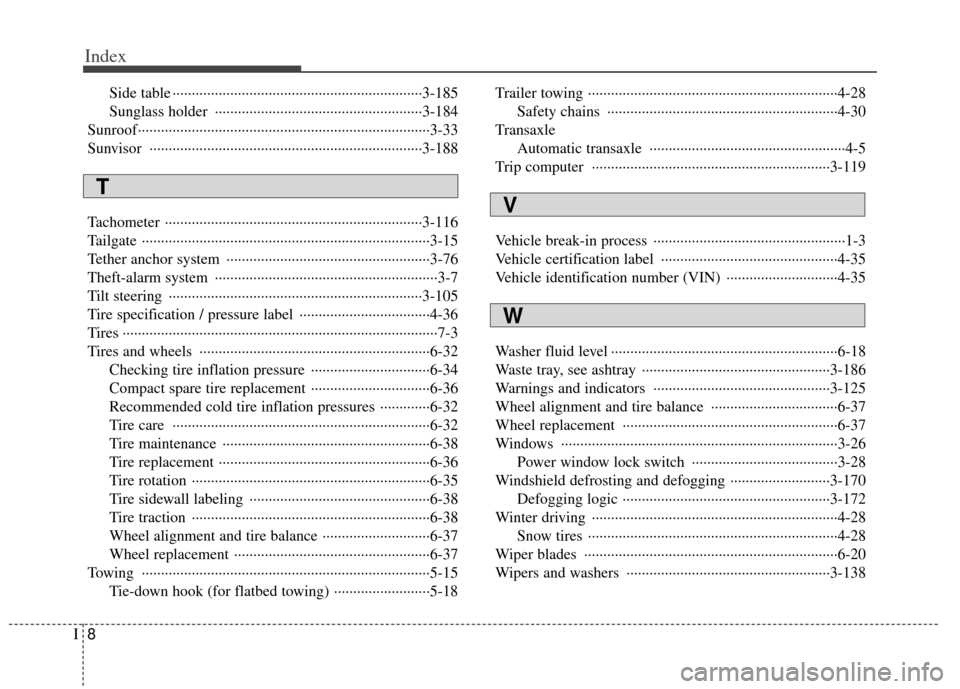
Index
8I
Side table ··················\
··················\
··················\
···········3-185
Sunglass holder ··················\
··················\
··················\
3-184
Sunroof··················\
··················\
··················\
··················\
····3-33
Sunvisor ·················\
··················\
··················\
··················\
3-188
Tachometer ················\
··················\
··················\
···············3-116
Tailgate ················\
··················\
··················\
··················\
·····3-15
Tether anchor system ··················\
··················\
·················3-76\
Theft-alarm system ··················\
··················\
··················\
····3-7
Tilt steering ··················\
··················\
··················\
············3-105
Tire specification / pressure label ··················\
················4-36
Tires ··················\
··················\
··················\
··················\
··········7-3
Tires and wheels ··················\
··················\
··················\
······6-32 Checking tire inflation pressure ··················\
·············6-34
Compact spare tire replacement ··················\
·············6-36
Recommended cold tire inflation pressures ·············6-32
Tire care ··················\
··················\
··················\
·············6-32
Tire maintenance ··················\
··················\
··················\
6-38
Tire replacement ··················\
··················\
··················\
·6-36
Tire rotation ··················\
··················\
··················\
········6-35
Tire sidewall labeling ··················\
··················\
···········6-38
Tire traction ··················\
··················\
··················\
········6-38
Wheel alignment and tire balance ··················\
··········6-37
Wheel replacement ··················\
··················\
···············6-37
Towing ·················\
··················\
··················\
··················\
····5-15 Tie-down hook (for flatbed towing) ··················\
·······5-18 Trailer towing ··················\
··················\
··················\
···········4-28
Safety chains ··················\
··················\
··················\
······4-30
Transaxle Automatic transaxle ··················\
··················\
···············4-5
Trip computer ··················\
··················\
··················\
········3-119
Vehicle break-in process ··················\
··················\
··············1-3
Vehicle certification label ··················\
··················\
··········4-35
Vehicle identification number (VIN) ··················\
···········4-35
Washer fluid level ··················\
··················\
··················\
·····6-18
Waste tray, see ashtray ··················\
··················\
·············3-186
Warnings and indicators ··················\
··················\
··········3-125
Wheel alignment and tire balance ··················\
···············6-37
Wheel replacement ··················\
··················\
··················\
··6-37
Windows ··················\
··················\
··················\
··················\
3-26 Power window lock switch ··················\
··················\
··3-28
Windshield defrosting and defogging ··················\
········3-170 Defogging logic ··················\
··················\
··················\
3-172
Winter driving ··················\
··················\
··················\
··········4-28 Snow tires ··················\
··················\
··················\
···········4-28
Wiper blades ··················\
··················\
··················\
············6-20
Wipers and washers ··················\
··················\
·················3-13\
8
T
V
W
Page 287 of 370
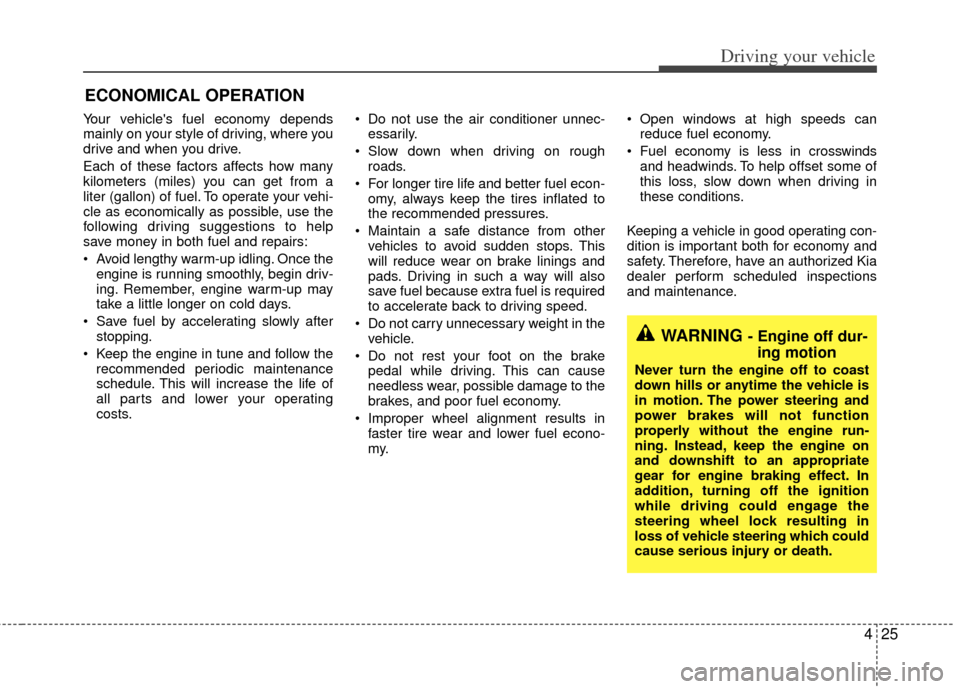
425
Driving your vehicle
Your vehicle's fuel economy depends
mainly on your style of driving, where you
drive and when you drive.
Each of these factors affects how many
kilometers (miles) you can get from a
liter (gallon) of fuel. To operate your vehi-
cle as economically as possible, use the
following driving suggestions to help
save money in both fuel and repairs:
Avoid lengthy warm-up idling. Once theengine is running smoothly, begin driv-
ing. Remember, engine warm-up may
take a little longer on cold days.
Save fuel by accelerating slowly after stopping.
Keep the engine in tune and follow the recommended periodic maintenance
schedule. This will increase the life of
all parts and lower your operating
costs. Do not use the air conditioner unnec-
essarily.
Slow down when driving on rough roads.
For longer tire life and better fuel econ- omy, always keep the tires inflated to
the recommended pressures.
Maintain a safe distance from other vehicles to avoid sudden stops. This
will reduce wear on brake linings and
pads. Driving in such a way will also
save fuel because extra fuel is required
to accelerate back to driving speed.
Do not carry unnecessary weight in the vehicle.
Do not rest your foot on the brake pedal while driving. This can cause
needless wear, possible damage to the
brakes, and poor fuel economy.
Improper wheel alignment results in faster tire wear and lower fuel econo-
my. Open windows at high speeds can
reduce fuel economy.
Fuel economy is less in crosswinds and headwinds. To help offset some of
this loss, slow down when driving in
these conditions.
Keeping a vehicle in good operating con-
dition is important both for economy and
safety. Therefore, have an authorized Kia
dealer perform scheduled inspections
and maintenance.
ECONOMICAL OPERATION
WARNING - Engine off dur- ing motion
Never turn the engine off to coast
down hills or anytime the vehicle is
in motion. The power steering and
power brakes will not function
properly without the engine run-
ning. Instead, keep the engine on
and downshift to an appropriate
gear for engine braking effect. In
addition, turning off the ignition
while driving could engage the
steering wheel lock resulting in
loss of vehicle steering which could
cause serious injury or death.
Page 299 of 370
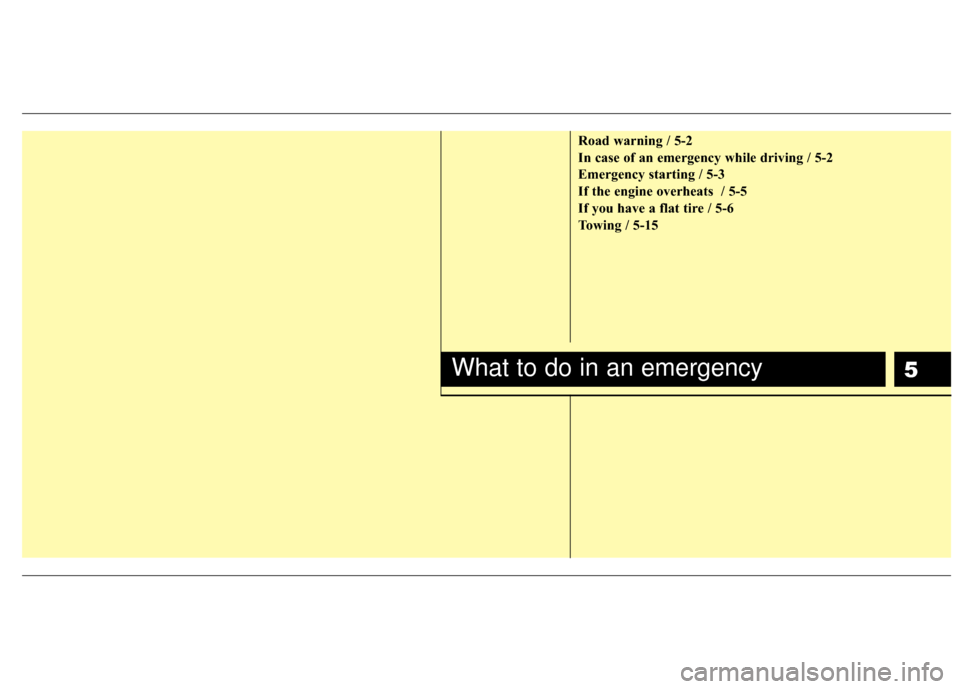
5
Road warning / 5-2
In case of an emergency while driving / 5-2
Emergency starting / 5-3
If the engine overheats / 5-5
If you have a flat tire / 5-6
Towing / 5-15
What to do in an emergency
Page 300 of 370
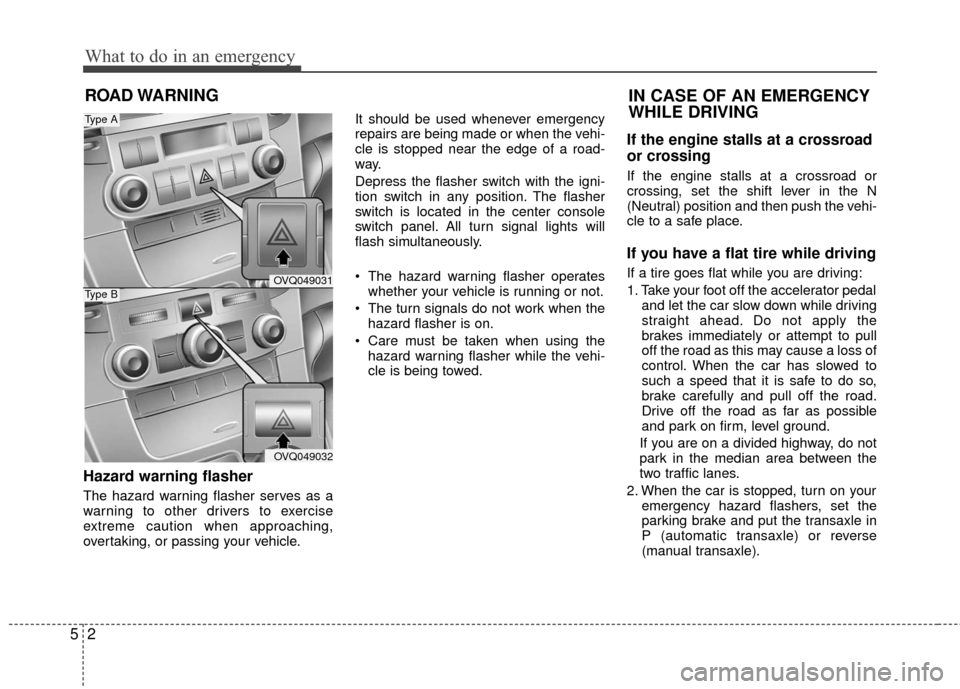
What to do in an emergency
25
ROAD WARNING
Hazard warning flasher
The hazard warning flasher serves as a
warning to other drivers to exercise
extreme caution when approaching,
overtaking, or passing your vehicle.It should be used whenever emergency
repairs are being made or when the vehi-
cle is stopped near the edge of a road-
way.
Depress the flasher switch with the igni-
tion switch in any position. The flasher
switch is located in the center console
switch panel. All turn signal lights will
flash simultaneously.
• The hazard warning flasher operates
whether your vehicle is running or not.
The turn signals do not work when the hazard flasher is on.
Care must be taken when using the hazard warning flasher while the vehi-
cle is being towed.
If the engine stalls at a crossroad
or crossing
If the engine stalls at a crossroad or
crossing, set the shift lever in the N
(Neutral) position and then push the vehi-
cle to a safe place.
If you have a flat tire while driving
If a tire goes flat while you are driving:
1. Take your foot off the accelerator pedal and let the car slow down while driving
straight ahead. Do not apply the
brakes immediately or attempt to pull
off the road as this may cause a loss of
control. When the car has slowed to
such a speed that it is safe to do so,
brake carefully and pull off the road.
Drive off the road as far as possible
and park on firm, level ground.
If you are on a divided highway, do not
park in the median area between the
two traffic lanes.
2. When the car is stopped, turn on your emergency hazard flashers, set the
parking brake and put the transaxle in
P (automatic transaxle) or reverse
(manual transaxle).OVQ049031
OVQ049032
Type A
Type B
IN CASE OF AN EMERGENCY
WHILE DRIVING
Page 301 of 370
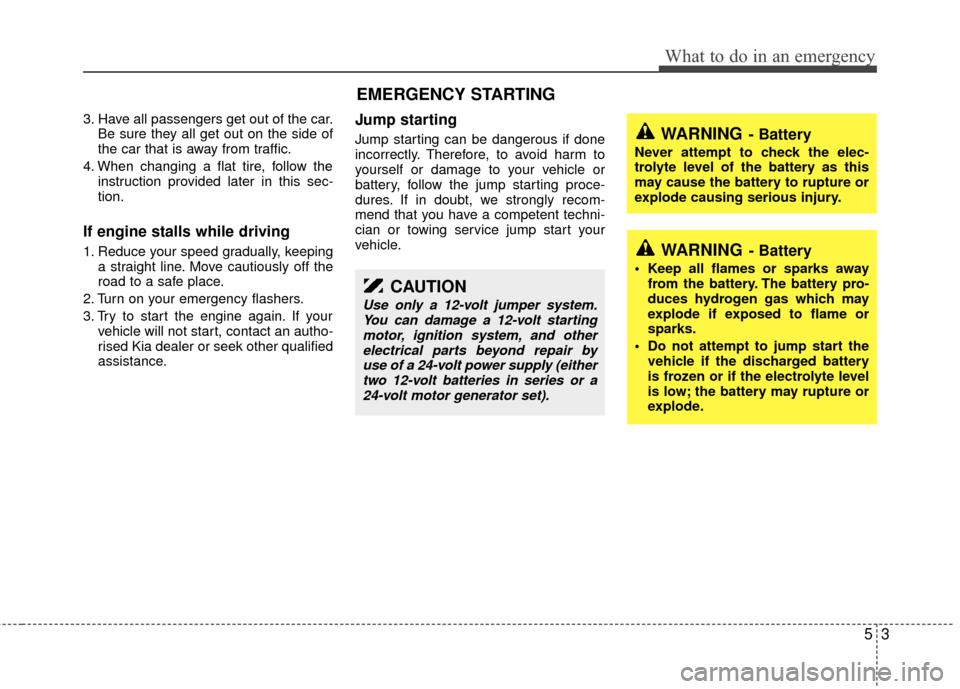
53
What to do in an emergency
3. Have all passengers get out of the car.Be sure they all get out on the side of
the car that is away from traffic.
4. When changing a flat tire, follow the instruction provided later in this sec-
tion.
If engine stalls while driving
1. Reduce your speed gradually, keepinga straight line. Move cautiously off the
road to a safe place.
2. Turn on your emergency flashers.
3. Try to start the engine again. If your vehicle will not start, contact an autho-
rised Kia dealer or seek other qualified
assistance.
Jump starting
Jump starting can be dangerous if done
incorrectly. Therefore, to avoid harm to
yourself or damage to your vehicle or
battery, follow the jump starting proce-
dures. If in doubt, we strongly recom-
mend that you have a competent techni-
cian or towing service jump start your
vehicle.
WARNING- Battery
• Keep all flames or sparks awayfrom the battery. The battery pro-
duces hydrogen gas which may
explode if exposed to flame or
sparks.
Do not attempt to jump start the vehicle if the discharged battery
is frozen or if the electrolyte level
is low; the battery may rupture or
explode.
EMERGENCY STARTING
WARNING- Battery
Never attempt to check the elec-
trolyte level of the battery as this
may cause the battery to rupture or
explode causing serious injury.
CAUTION
Use only a 12-volt jumper system.You can damage a 12-volt startingmotor, ignition system, and otherelectrical parts beyond repair by use of a 24-volt power supply (eithertwo 12-volt batteries in series or a24-volt motor generator set).
Page 304 of 370
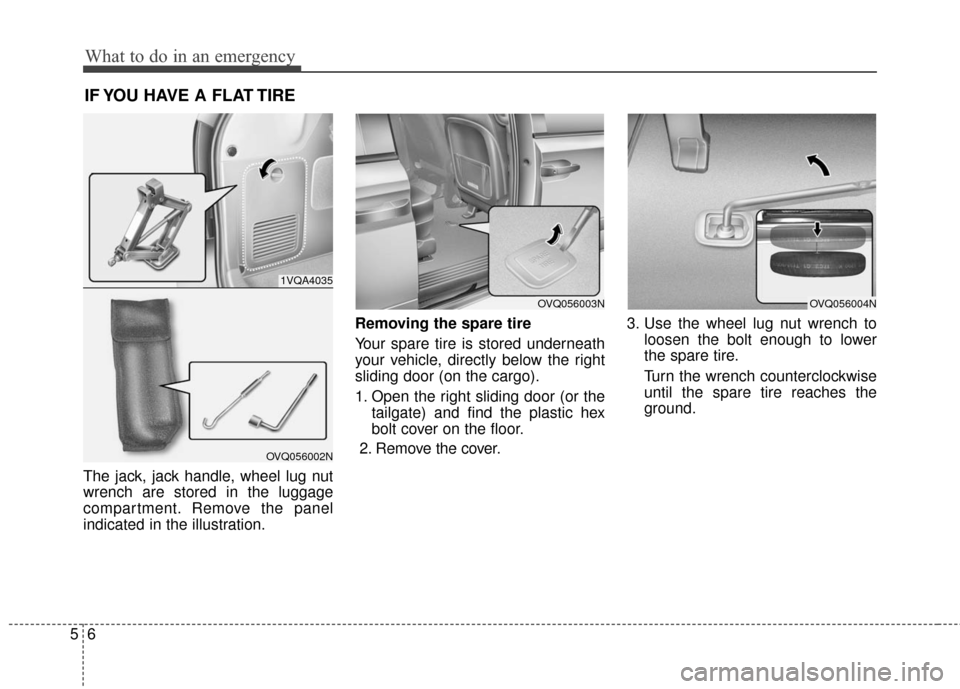
What to do in an emergency
65
IF YOU HAVE A FLAT TIRE
The jack, jack handle, wheel lug nut
wrench are stored in the luggage
compartment. Remove the panel
indicated in the illustration.Removing the spare tire
Your spare tire is stored underneath
your vehicle, directly below the right
sliding door (on the cargo).
1. Open the right sliding door (or the
tailgate) and find the plastic hex
bolt cover on the floor.
2. Remove the cover. 3. Use the wheel lug nut wrench to
loosen the bolt enough to lower
the spare tire.
Turn the wrench counterclockwise
until the spare tire reaches the
ground.
1VQA4035
OVQ056002N
OVQ056003NOVQ056004N
Page 306 of 370
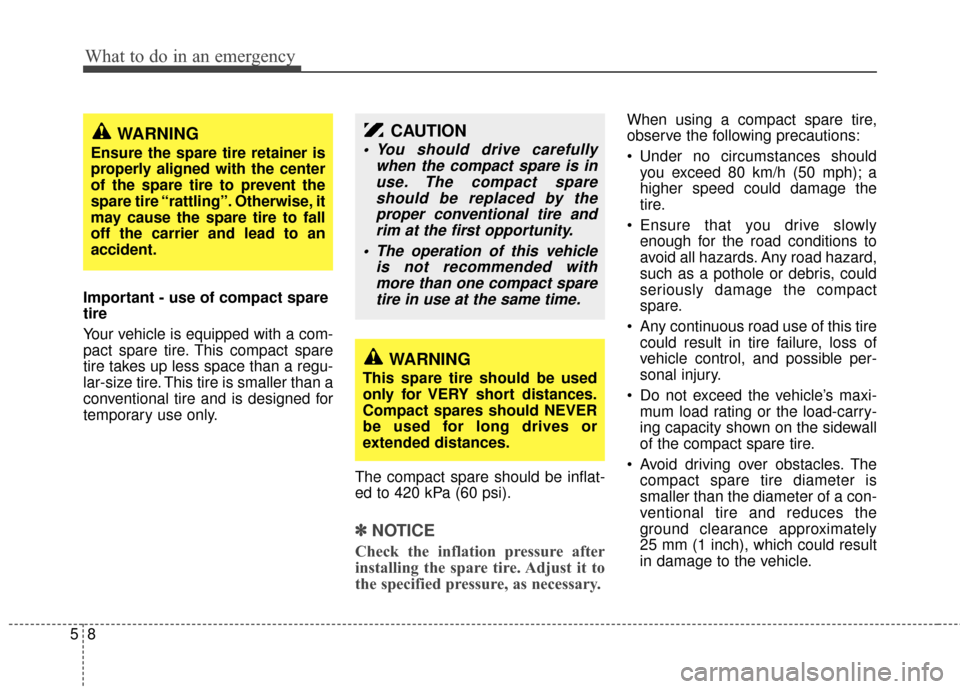
What to do in an emergency
85
Important - use of compact spare
tire
Your vehicle is equipped with a com-
pact spare tire. This compact spare
tire takes up less space than a regu-
lar-size tire. This tire is smaller than a
conventional tire and is designed for
temporary use only.The compact spare should be inflat-
ed to 420 kPa (60 psi).
✽ ✽NOTICE
Check the inflation pressure after
installing the spare tire. Adjust it to
the specified pressure, as necessary.
When using a compact spare tire,
observe the following precautions:
Under no circumstances should
you exceed 80 km/h (50 mph); a
higher speed could damage the
tire.
Ensure that you drive slowly enough for the road conditions to
avoid all hazards. Any road hazard,
such as a pothole or debris, could
seriously damage the compact
spare.
Any continuous road use of this tire could result in tire failure, loss of
vehicle control, and possible per-
sonal injury.
Do not exceed the vehicle’s maxi- mum load rating or the load-carry-
ing capacity shown on the sidewall
of the compact spare tire.
Avoid driving over obstacles. The compact spare tire diameter is
smaller than the diameter of a con-
ventional tire and reduces the
ground clearance approximately
25 mm (1 inch), which could result
in damage to the vehicle.CAUTION
You should drive carefully when the compact spare is inuse. The compact spareshould be replaced by theproper conventional tire andrim at the first opportunity.
The operation of this vehicle is not recommended withmore than one compact sparetire in use at the same time.
WARNING
This spare tire should be used
only for VERY short distances.
Compact spares should NEVER
be used for long drives or
extended distances.
WARNING
Ensure the spare tire retainer is
properly aligned with the center
of the spare tire to prevent the
spare tire “rattling”. Otherwise, it
may cause the spare tire to fall
off the carrier and lead to an
accident.